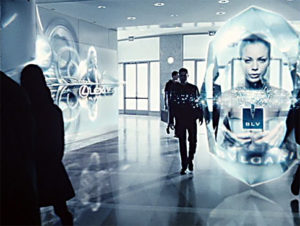 The big news from Google this week came out of the company’s secret Mountain View ‘Google X’ laboratories that work on long term R&D projects. The New York Times reported that Google’s rumored ‘augmented reality’ glasses would be released to consumers by the end of 2012. The glasses will run on the Android OS as well as attach to an Android smart phone or tablet, imbuing its wearer with the magical ability to see a different digital dimension as he looks at the world around him.
The big news from Google this week came out of the company’s secret Mountain View ‘Google X’ laboratories that work on long term R&D projects. The New York Times reported that Google’s rumored ‘augmented reality’ glasses would be released to consumers by the end of 2012. The glasses will run on the Android OS as well as attach to an Android smart phone or tablet, imbuing its wearer with the magical ability to see a different digital dimension as he looks at the world around him.
Augmented reality isn’t new – there are already a plethora of Android and iPhone apps that enable a user to point their phone’s camera at storefronts and historical landmarks to pull up relevant facts and reviews. However, the glasses add an invaluable ingredient to the augmented reality stew – the option to completely ‘plug in’ to a different world. Although the difference between holding a phone up and wearing a heads up display seems logistical at most, the change is literally worlds apart. Imagine walking around downtown and seeing digital edits everywhere – notes from friends, city street soundtracks, construction notices, public transportation estimates, and advertising.
The last note is clearly why Google is moving to become the emperor of augmented reality. Adwords advertising already reaches users through search results, display network websites, YouTube videos and mobile sites – the next major foray is the real world. The effectiveness of placing customized ads into the real world – ala ‘Minority Report – would be unquestionable. Privacy and ethical concerns are obviously an issue, but then again they’ve always been an issue with the internet and that hasn’t stopped advertising from spreading to every corner of the web.
The real question is how Google will fuse augmented advertising and its Adwords platform. The company’s most successful and lucrative programs have always been Pay-Per-Click (PPC) driven. Will users be served ‘tidbits’ on their heads up display that entice them to ‘click’ to find out more? Or will augmented advertising be primarily impression driven; almost a step backwards to the old world style of billboards and paper pamphlets.
This new realm of advertising could actually become a bridge between the primarily data driven digital marketers who work with PPC and SEO and ‘old-school’ advertising agencies who create expansive visual brands. For a user that is ‘plugged in’ to augmented reality for a large portion of their day – simple text ads floating around probably won’t cut it. A user will require a more elegant advertising experience that seamlessly works into their line of sight.
Those advertising agencies that are at the cutting edge of both worlds and can also be open to new creative solutions, will likely be the next generation’s leaders.